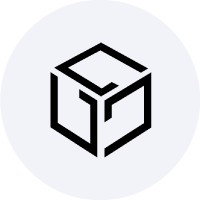


Four PreisFORM
FORM zu EUR Umrechner
Wie denken Sie heute über Four?
Über Four (FORM)
Was ist BinaryX?
BinaryX ist eine GameFi-Plattform, die sich in der Blockchain-Gaming-Branche einen Namen gemacht hat. Das Projekt ist bekannt für die Entwicklung und das Hosting von Blockchain-basierten Spielen, die den Nervenkitzel des Spielens mit den Prinzipien der dezentralen Finanzierung (DeFi) verbinden. BinaryX begann seine Reise als dezentralisiertes Derivat-Handelssystem, passte sich aber schnell den aufkommenden Trends von GameFi und dem Metaverse an und entwickelte sich zu einer Drehscheibe für innovative Spielerfahrungen. Das Engagement von BinaryX für die Nutzung der Blockchain-Technologie zeigt sich in seinen beliebten Spielen wie CyberDragon, CyberChess und CyberLand, die alle auf der BNB Chain laufen.
Die Philosophie der Plattform geht über das reine Spielen hinaus; sie fördert ein Ökosystem, in dem die Spieler ein integraler Bestandteil der Wirtschaft des Spiels sind und von dessen Wachstum und Erfolg profitieren können. Dieser spielerzentrierte Ansatz hat maßgeblich zum Aufstieg von BinaryX beigetragen, da er den Nutzern echtes Eigentum, Engagement in der Community und einen Anteil an den finanziellen Gewinnen bietet. Mit der Einführung einer Dezentralen Autonomen Organisation (DAO) hat BinaryX seinen Spielern auch die Möglichkeit gegeben, Entscheidungen zu treffen, was seine Position als führendes Unternehmen im GameFi-Sektor weiter festigt.
Ressourcen
Whitepaper: https://binaryx.pro/whitepaper
Offizielle Website: h ttps://www.binaryx.pro/
Wie funktioniert BinaryX?
BinaryX ist eine Plattform mit zwei Funktionen, die sowohl als Entwickler von Blockchain-Spielen als auch als Startrampe für ein Initial Game Offering (IGO) für andere Spieleentwickler dient. Dank dieser Doppelfunktionalität kann BinaryX nicht nur seine eigenen Spiele entwickeln, sondern auch von anderen entwickelte Spiele unterstützen und auf den Markt bringen. Die Plattform bietet Entwicklern eine umfassende Serviceplattform, darunter eine robuste NFT-Asset-Trading-Plattform, eine für GameFi optimierte Hochgeschwindigkeits-Sidechain und eine IGO-Plattform, die neuen Spielen dabei hilft, Besucher anzuziehen und Mittel zu beschaffen.
Der plattformeigene Token BNX dient als primäre In-Game-Währung und als Assets zur Finanzierung der Spielentwicklung. BNX-Inhaber können sich an der Governance der Community beteiligen, über wichtige Entscheidungen abstimmen und haben Zugang zu verschiedenen Aktionen zur Einbindung der Community. Das Engagement von BinaryX für Innovationen zeigt sich auch in der Investition in eine GameFi-Sidechain, die verbesserte Transaktionsgeschwindigkeiten, niedrigere Gasgebühren und Interoperabilität mit dem BNB Chain Hauptnetzwerk verspricht.
Was ist BNX Token?
BNX ist der native Token des BinaryX-Ökosystems. Er wird für In-Game-Transaktionen, als Governance-Token für DAO-Abstimmungen und als Prämie für Beiträge zur Community verwendet. Der BNX-Token wurde auch zur Finanzierung der Entwicklung neuer Spieleprojekte durch den Cyber Incubation Fund verwendet, was das Engagement von BinaryX zur Förderung von Innovationen im GameFi-Bereich unterstreicht.
Anfang 2023 führte BinaryX einen strategischen Token-Split durch, um sein Wirtschaftsmodell zu verfeinern und die Eintrittsbarriere zu senken, mit dem Ziel, die Akzeptanz von BNX zu erhöhen. Diese Entscheidung, die von einer Mehrheit der Community durch eine Abstimmung der DAO unterstützt wurde, unterstreicht das Engagement der Plattform für das Engagement der Community und die Transparenz. Heute ist BNX ein robuster Token mit einer starken Performance auf dem Markt, der das umfangreiche Spielangebot von BinaryX und die Initiativen der Community untermauert.
Was bestimmt den Preis von BinaryX?
Der Kurs von BinaryX (BNX) wird durch eine Kombination von Faktoren beeinflusst, die für Kryptowährungen aus dem Blockchain- und GameFi-Sektor typisch sind. Die Marktnachfrage ist ein wichtiger Faktor, der durch die Beliebtheit und das Engagement der Nutzer der Blockchain-Spiele von BinaryX bestimmt wird. Da die Spieler versuchen, BNX für In-Game-Transaktionen, die Teilnahme an der Governance oder Investitionen in neue Spiele auf der Plattform zu erwerben, kann die erhöhte Nachfrage zu einem Anstieg des Token-Preises führen. Darüber hinaus tragen der Erfolg und die Viralität von Spielen wie CyberDragon und CyberChess zum wahrgenommenen Wert von BNX bei, da diese Vorzeigetitel mehr Nutzer in das BinaryX-Ökosystem ziehen.
Ein weiterer entscheidender Faktor ist die allgemeine Stimmung auf dem Krypto-Markt, die durch allgemeinere wirtschaftliche Aktionen, regulatorische Nachrichten und Veränderungen im Vertrauen der Anleger beeinflusst werden kann. Der Kurs von BinaryX reagiert auch auf technologische Fortschritte und strategische Entscheidungen, wie z. B. Token-Splits oder Aktualisierungen der Spielplattform. Der von BinaryX durchgeführte Token-Split war beispielsweise ein strategischer Schritt, um das Wirtschaftsmodell zu verbessern und den Token zugänglicher zu machen, was sich möglicherweise auf den Preis auswirkt, indem die Angebotsdynamik des Tokens verändert wird.
Darüber hinaus kann die Integration von DeFi-Elementen in die Spielplattform von BinaryX, wie z. B. Staking-Prämien und der Cyber Incubation Fund, einen zusätzlichen Wert für BNX schaffen. Indem BinaryX Spielern und Anlegern verschiedene Möglichkeiten bietet, Erträge aus ihren BNX-Beständen zu erwirtschaften, schafft BinaryX nicht nur Anreize für das Halten des Tokens, sondern erhöht auch potenziell seinen Nutzen und seine Seltenheit. Das transparente Governance-Modell der Plattform, das BNX-Inhabern die Möglichkeit gibt, über wichtige Entscheidungen abzustimmen, kann ebenfalls Vertrauen in den Wert des Tokens schaffen, da es einen von der Community gesteuerten Ansatz für Wachstum und Innovation widerspiegelt. Diese Elemente, zusammen mit der laufenden Entwicklung der Plattform und den Initiativen der Community, spielen eine wichtige Rolle bei der Gestaltung des Kursverlaufs von BNX in der volatilen Welt der Krypto-Investitionen.
Diejenigen, die sich für die Investition oder das Trading mit BNX interessieren, werden sich vielleicht fragen: Wo kann man BinaryX kaufen? Sie können BinaryX an führenden Börsen wie Bitget kaufen, die eine sichere und nutzerfreundliche Plattform für Krypto-Enthusiasten bieten.
AI-Analysebericht über Four
Live Four Preis heute in EUR
Four Preisverlauf (EUR)
 Niedrigster Preis
Niedrigster Preis Höchster Preis
Höchster Preis 
Was ist der höchste Preis von Four?
Was ist der niedrigste Preis von Four?
Four Preisvorhersage
Wie hoch wird der Preis von FORM in 2026 sein?
Wie hoch wird der Preis von FORM in 2031 sein?
FAQ
Welche Faktoren beeinflussen den Preis von Four coin?
Wo kann ich Four coin kaufen?
Warum ist der Preis von Four coin so volatil?
Wie kann ich den Preis von Four coin in Echtzeit verfolgen?
Hat der Preis von Four coin bereits sein Allzeithoch erreicht?
Was ist die zukünftige Preiserwartung für Four coin?
Ist Four coin eine gute Investition?
Können globale wirtschaftliche Ereignisse den Preis von Four coin beeinflussen?
Was sind die Risiken, die mit der Investition in Four coin verbunden sind?
Welche Strategien kann ich verwenden, um Four Coin effektiv zu handeln?
Wie hoch ist der aktuelle Preis von Four?
Wie hoch ist das 24-Stunden-Trading-Volumen von Four?
Was ist das Allzeithoch von Four?
Kann ich Four auf Bitget kaufen?
Kann ich mit Investitionen in Four ein regelmäßiges Einkommen erzielen?
Wo kann ich Four mit der niedrigsten Gebühr kaufen?
Four Nachrichten
Four Bestände nach Konzentration
Four Adressen nach Haltezeit

Globale Four Preise
- 1
- 2
- 3
- 4
- 5
Wie man Four(FORM) kauft

Erstellen Sie Ihr kostenloses Bitget-Konto

Verifizieren Sie Ihr Konto

Four in FORM konvertieren
Schließen Sie sich FORM Copy-Trading an, indem Sie Elite-Tradern folgen.
Neue Listings auf Bitget
Mehr kaufen
Wo kann ich Four (FORM) kaufen?
Videobereich - schnelle Verifizierung, schnelles Trading

FORM zu EUR Umrechner
Four Bewertungen
Bitget Insights



Verwandte Assets
Zusätzliche Informationen über Four
Coin-Übersicht
Coin bezogen
Trading bezogen
Traden
Earn
BTC/USDT
SpotBTC/USDT
MarginBTC/USDT
USDT-M FuturesBTC/USD
Coin-M Futures
































Four Soziale Daten
In den letzten 24 Stunden betrug der Stimmungswert in den sozialen Medien für Four 3, und die Stimmung in den sozialen Medien in Bezug auf den Preistrend von Four war Bullisch. Der Gesamt-Social-Media-Score von Four war 0, was den 89 unter allen Kryptowährungen einnimmt.
Laut LunarCrush wurden Kryptowährungen in den letzten 24 Stunden insgesamt 1,058,120 in den sozialen Medien erwähnt, wobei Four mit einem Häufigkeitsverhältnis von 0.01% erwähnt wurde und unter allen Kryptowährungen den Rang 378 einnimmt.
In den letzten 24 Stunden gab es insgesamt 303 einzigartige Nutzer, die über Four diskutierten, mit insgesamt Four Erwähnungen von 94. Im Vergleich zum vorangegangenen 24-Stunden-Zeitraum hat sich jedoch die Zahl der einzelnen Nutzer Anstieg um 2% und die Gesamtzahl der Erwähnungen Anstieg um 1% verändert.
Auf Twitter gab es in den letzten 24 Stunden insgesamt 1 Tweets, in denen Four erwähnt wurde. Davon sind Bulllisch für Four, 100% Bärisch für Four, und 0% sind neutral für Four.
Auf Reddit gab es in den letzten 24 Stunden 18 Beiträge, in denen Four erwähnt wurde. Im Vergleich zum vorherigen 24-Stunden-Zeitraum hat sich die Anzahl der Erwähnungen Anstieg um 50% erhöht.
Übersicht über alle sozialen Aspekte
3